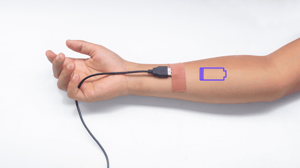Chinese researchers have created a wearable material that, using the movements of the body, is able to "induce" and store weak electrical currents, capable of powering a smartwatch or other device.
Bioengineers at Tsinghua University (Beijing) have created a fabric that, simply by virtue of being worn, and therefore subjected to body movement, generates electricity (a weak but significant electrical current). The system stores it and can use it to power one or more devices (such as a smartwatch) or a system to monitor vital functions.
The results of studies into this new, advanced type of material have been published in the scientific journal Nano Research Energy. The Chinese researchers thus appear to have achieved a long-pursued goal: that of being able to use an electrical generation and charging system that functions independently of separate batteries.
The fabric, called fiber-TENG, also contains nanomaterials (in particular, carbon nanotubes)—in other words, materials designed to be between 1 and 100 nanometres in size (one nanometre, you may recall, equals one billionth of a metre). Their extremely small scale means that the properties of nanomaterials differ from those of their larger counterparts.
A high-tech fabric made up of three layers
The fabric created by the researchers at Tsinghua University, one of China's most important institutions of its kind, consists of three parallel layers: one of polylactic acid (a polymer used in 3D printers), one of reduced graphene oxide (heavily used in a variety of fields) and polypyrrole (a substance already frequently used in the medical sector and beyond). The abbreviated name for this "sandwich" is "PLA-rGO-PPy".
These materials make up the weave of a fabric that uses triboelectricity—in other words, the irregular electricity that, in some materials, is naturally generated by friction, thanks to normal body movement. Fiber-TENG is able to harvest that energy, which is low-frequency, and collect it in a fabric with a slightly different composition, called fiber-SC and made using graphene oxide, which contains the nanotubes and ensures what is perhaps its most desirable function: the ability, as mentioned above, to use these weak electrical currents to power external devices.
Fiber-SC can be inserted into the TENG fabric in a specific area, for example at the wrist, and from there it can send the electricity where it is needed: to a smartwatch, wireless earbuds or a heart rate monitor. However, researchers believe that the electricity thus generated can also serve to power other types of applications, like those for monitoring the body after a hospital stay or a surgical procedure or for monitoring certain pathogenic micro-organisms.
Light, flexible and relatively easy to make
All of this, the researchers write, will function routinely for a high number of cycles; the fabric is very light and flexible, pleasant to wear and even relatively simple to make, because it is composed of sustainable parts that are already available on the market (even if the “assembly” process does, in fact, call for very advanced techniques).
Now the team wishes to explore potential "real world" uses for the fabric, outside of academic laboratories. That is why—as we can read in a statement issued by Tsinghua University—the design and manufacturing processes are going to be optimized and the fabric's performance under different conditions studied.




